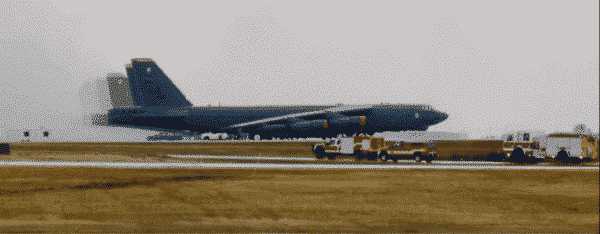Originally introduced in 1955, the Boeing B-52 has stood the test of time as one of the most valuable aircraft for the United States military. The massive bomber, used by the Air Force and by NASA, can haul some 70,000lbs of gear across more than 8,000 miles without stopping.
A video posted to YouTube shows a handful of these powerful beasts in action during a training exercise on a rain soaked tarmac in North Dakota. The aircraft are there to demonstrate their immense capabilities and further prove just how vital they are and why they continue to grace the skies more than half a century later.

Twelve 5th Bomb Wing B-52’s and their crews take off during Prairie Vigilance exercise at Minot Air Force Base, North Dakota (ArmedForcesUpdate/YouTube)
The video begins with a bit of information regarding the B-52s and the exercise they are apart of.
“Twelve 5th Bomb Wing B-52’s and their crews took off during Prairie Vigilance exercise at Minot Air Force Base, North Dakota,” the video says. “Prairie Vigilance is an annual exercises designed to test the wing’s ability to conduct conventional and nuclear-capable bomber operations.”
Check out the B-52’s in action in the video below:
In the video, the massive aircraft can be seen waking from their slumber in a smokey startup procedure. The beasts slowly crawl along the runway as they prepare for takeoff. It takes a minimum of five crewman – consisting of a pilot, copilot, weapons systems officer, navigator and warfare officer – to fly the aircraft.
One after the other, the aircraft take to the skies as if they were light as a feather. In fact, even an empty B-52 tips the scales at an astounding 185,000lbs.

Twelve 5th Bomb Wing B-52’s and their crews take off during Prairie Vigilance exercise at Minot Air Force Base, North Dakota (ArmedForcesUpdate/YouTube)
When it comes to its armament, the B-52 bomber is capable of deploying the widest array of weapons of any U.S. aircraft. The massive plane packs gravity bombs, cluster bombs, precision guided missiles and joint direct attack munitions during a conventional mission.
The aircraft, 26 feet wider than it his long, can speed through the air at more than 600 mph and 50,000 feet above the ground.

Twelve 5th Bomb Wing B-52’s and their crews take off during Prairie Vigilance exercise at Minot Air Force Base, North Dakota (ArmedForcesUpdate/YouTube)
As of 2015, there are currently 58 B-52’s in active duty with 18 waiting in reserve. Following successful upgrades in 2013 and 2015, the fleet of B-52’s is expected to remain ins service until at least 2050.



